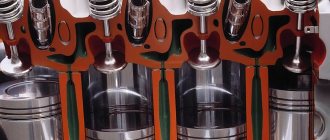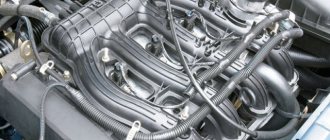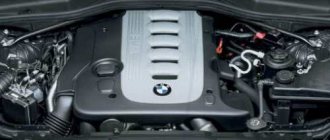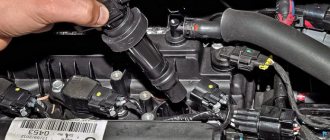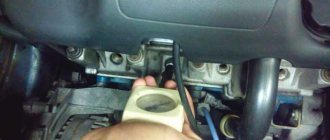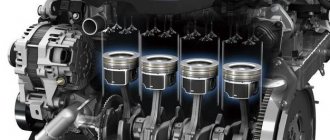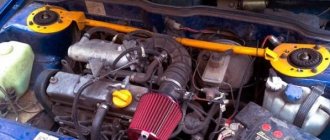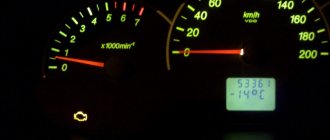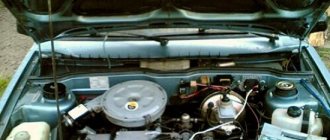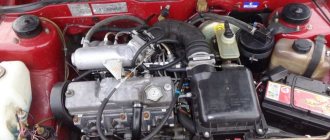The engine stalls when hot: reasons
To determine the main reasons, you need to know the design features of the power unit. Thus, not all motorists are able to identify the cause and also repair the breakdown on their own. Therefore, if the owner of the power plant doubts his abilities, it is recommended to contact the car service directly.
Is the engine running hot? Let's determine the main causes and nodes of the problem:
- Problems in the ignition system. This includes spark plugs, high-voltage wires, as well as the ignition coil and switch.
- Formation of an air-fuel mixture. In this category, the cause will be the fuel and air filter, carburetor or injector.
- Wear of the engine, namely components such as piston rings, valves or valve stem seals.
- The presence of air leaks for one reason or another.
- Malfunctions associated with broken sensors or errors in the motor control unit.
Air leak
The presence of excess air in the cylinders can cause tripping. Thus, excess oxygen can enter the power unit in several ways: through a broken head gasket, or be “sucked in” through the intake manifold gasket or injector.
The most common cause is a breakdown of the cylinder head gasket. To eliminate the problem, it is necessary to replace the gasket material. To do this you will have to dismantle the block head. This will allow access to the cylinders and valves, which also need to be diagnosed.
List of possible problems
Problem. After filling up with new gasoline, the check engine light started to come on, the car managed to warm up, but it started to stall after about 20-30 minutes of driving. Answer. In this case, it is not the ignition; the power supply and gas distribution system can also be discarded. It is necessary to check the integrity of the carburetor and fuel supply system. Replacing gasoline sometimes does not solve the problem.
This happens in some foreign cars with automatic transmissions. If you can’t find anything on your own, you should go to a service station; computer diagnostics should reveal the problem. There is no need to agree to replacing components without a reason, if the option will only possibly solve the problem. It is recommended to visit another service station.
Problem. Gasoline engine, injection type, misfires are shown in different cylinders during diagnostics. The spark plugs were replaced, all parts of the gas distribution system were cleaned and checked. Answer. The breakdown may be in the distributor cover or the ignition power supply: wiring, coils. It remains to check the fuel system as well.
Engine tripping is a very unpleasant defect that is difficult to get rid of. It is necessary to check all the above components, replace damaged parts - perhaps this will solve the problem. If all attempts are in vain, then you should go to a service station for diagnostics.
Spark plugs and armored wires
The first fundamental reason is the lack of spark in one of the cylinders. In this case, the candle stops working after heating. Many car enthusiasts do not know how to check spark plugs for performance at home.
This is done quite simply:
- Unscrew the spark plug from the cylinder.
- We put an armored wire on it.
- Connect the ground. You can attach it to the body, or you can attach a separate wire.
- Turn on the ignition for a few seconds.
- If the spark plug works, a spark will appear.
If the spark does not appear the first time, then it is worth trying a second time. If it is completely absent, you should take another high-voltage wire. If there is still no spark, then the problem is in the spark plug itself, and it needs to be replaced with a new one.
For spark plugs, it is always recommended to select according to the vehicle. This will help you not make a mistake when choosing a part. It is recommended to check the gaps between the contacts after purchase. Each engine will have its own, so it is worth studying the technical literature.
Armored wires also need to be checked for functionality. It is worth understanding that most elements have a resistance, which should be approximately 5 ohms. If the permissible value is less, then the wire is damaged and the part must be replaced.
Piston rings and valves
Wear of piston rings is one of the reasons for engine tripping. Many auto repairmen recommend performing the so-called “throwing” process, but this does not always help. Usually, when the rings are heavily worn, oil begins to enter the cylinder, which leads to contamination of the spark plug. It is because of this that the engine stalls when hot. In this case, it is necessary to carry out a major overhaul of the engine, bore the block and install the repair size of the rings and pistons.
The second reason is valves. If there is severe wear or burnout, a gap is formed through which excess gasoline flows. The air-fuel mixture becomes “rich”, which leads to “choking” of the engine. This effect is most visible when the engine starts up when you press the gas pedal. In this case, the most correct solution is a major overhaul of the cylinder head with replacement of guide bushings, valves and seats.
Carburetor faulty
Many car enthusiasts have wondered why the engine stalls at speed, especially in carburetor cars. This has to do with the fuel supply. If the carburetor is severely worn, fuel does not flow evenly into the cylinders, but, accordingly, either a lot or a little. In this case, after pressing the gas pedal to overtake or advance, fuel enters the intake manifold unevenly, the engine begins to “chop” and shoot into the exhaust.
To eliminate the malfunction, it is necessary to dismantle the carburetor and clean it with a bulkhead. To do this you will need a repair kit. Most motorists do not contact a car service center to carry out such an operation, but carry out the repairs themselves, since the procedure is quite simple. The only subtlety is the setting and adjustment of the injection element.
Problems in the injector
We will consider injector malfunctions associated with engine tripping using the Lada engine as an example. In this case, the most likely cause is the injectors. Clogging of one of the parts can lead to an imbalance in the air-fuel mixture. This effect is called a “lean” mixture, since there is not enough fuel for normal ignition. It is for this reason that the VAZ engine (injector) is tripping.
To fix the problem, you need to dismantle the car's injectors and carry out diagnostics using a special stand that will show which part has failed. You can do the diagnostic operation yourself. To do this, you will have to remove the fuel rail, but do not disconnect it from the power system. After turning on the fuel supply pump, you will see which of the injectors is spraying fuel incorrectly. Thus, having identified the faulty element, it is worth replacing it and eliminating the reason why the VAZ engine stalls when hot.
Ignition timing failure
When it is impossible to determine the exact position of the inoperative cylinder, the ignition timing system should be checked. In injection engines, the ignition is controlled by an electronic unit,
therefore, the correctness of its operation can only be determined by computer diagnostics. You can continue troubleshooting by eliminating this cause.
Mix quality
The fuel mixture is prepared from gasoline and air. Their quantitative composition affects the operation of the Chevrolet Niva engine. The lack of air is usually due to a clogged air filter.
Excessive amounts indicate a “suction”. On this car, air leaks often occur at the attachment point of the vacuum brake booster pipe,
but don't forget about the throttle position sensor.
The mixture may be of poor quality due to clogged nozzles. Worn o-rings cause depressurization of the fuel system or air leaks. The solution to this situation is to replace the injector seals.
Low compression
The most unpleasant thing that an owner can expect is low compression, which can be measured with a special device. Here you cannot do without disassembling or partially disassembling the engine. The reason lies in a burnt-out valve or severe wear of the piston group.
Under no circumstances should the high-voltage wire be removed from the spark plug while the engine is running. This “old-fashioned” method of diagnosis is fraught with electric shock. As a last resort, you can unscrew the spark plug, insert it into the sealing cap and visually evaluate the spark.
No ignition
The life of spark plugs is limited, so it is necessary to check their condition. After unscrewing all the spark plugs, you can detect if they are not working by inspection. A characteristic black soot will be visible on it, which covers the electrodes and subsequently interferes with the high-quality breakdown of the spark.
If replacing the spark plug does not help, then the engine may stall due to a faulty high-voltage wire.
Fuel ignition occurs early or, conversely, late.
Fuel ignition occurs late or, conversely, ahead of time due to faulty spark plugs, they produce a weak spark, or it appears at the wrong time. A weak spark appears due to the fact that carbon deposits accumulate on the spark plug, which prevents breakdown. Another reason that it is weak is the destruction of the insulator, and in the place where it is destroyed, soot appears, which prevents the normal appearance of a spark. If it does not appear at all, then this is most likely due to the fact that the cap of the spark plug has worn out or the wire through which current is supplied to the spark plug has failed, and the cause may also be a breakdown of the switch or a failed ignition coil.
There is excess or lack of air in the combustion chamber.
Excess air in the cylinders indicates that a depressurization has occurred in the air supply system. But lack of air can be caused by a dirty air filter or a broken throttle valve. The engine may not operate properly due to the failure of the sensor, which is responsible for the position of the throttle valve, as well as the sensor responsible for the operation of the mass air flow.
Fuel does not enter the cylinder evenly.
The reason that fuel unevenly enters the cylinder may be due to a malfunction of any parts of the fuel pump, for example: a pressure valve, pressure reducing or injection valve. But if fuel is supplied, on the contrary, in excess, then the problem is most likely in the fuel injectors; they may be clogged and need to be cleaned or replaced. If the electronic engine control unit fails, this will lead to improper operation of the power unit, as there will be an incorrect fuel supply.
Cracks
Cracks in the cylinder head or block are one of the most common causes of hot running. Metal, as is known, expands with increasing temperature; accordingly, small cracks can increase and allow little coolant to pass into the combustion chamber. This will interfere with the normal combustion of the mixture in the cylinder, and the engine will stall when warming up. The same effect occurs when a crack in the gasket under the block head expands and burns out.
Particular attention should be paid to motors with manual valve adjustment. The clearances must be set according to the manual for this type of engine; this cannot be ignored. If the valve is clamped, it will not close completely, the tightness in the combustion chamber is lost and the cylinder does not work when heated. If the gaps are set incorrectly, the valve itself and the seat burn out, it sinks into the head and the process becomes irreversible.
Wobbly piston rings also cause unbalanced engine operation when hot. Thermal changes in the metal, uneven wear, and engine overheating also play a role here. Runout of the camshaft journals leads to engine imbalance. The engine heats up and shakes, stalls periodically, and characteristic knocking noises appear.
ECM violation
In car electronics, the same problem with materials expansion exists. Boards, contacts, connectors are all subject to temperature changes. The quality of the materials themselves plays a big role here. Even a trivially extended contact on one of the coils or injector connector can cause the engine to trip on a warm car. Or a poor connection on the mass air flow sensor can cause the car to stall.
It's all about contacts. Here's another example. A common occurrence is the tripping of an eight-valve VAZ engine when hot due to a shorted ignition coil. The primary circuit overheats and does not produce a spark to one of the channels.
On a Kalina car, the electronic unit is located under the heater, or rather under the heater hose. With mileage, the clamp relaxes and antifreeze begins to drip, getting onto the block. It does not appear immediately, but when it heats up, the machine begins to trip due to a violation of the integrity of the tracks on the board.
Gasoline pump and its secrets
A malfunction associated with this miracle part is not always easy to find. You have to connect a pressure gauge to the injector rail, place it on the windshield and drive around, checking the fuel pressure as you go. This difficulty is associated with floating tripping on a hot one, if it does not always appear or only during movement. As it heats up, the rotor in the fuel pump begins to turn, the pressure drops and the engine runs rough. Trite and simple.
Worn needle valve and the presence of slag in the injectors can cause throbbing on a warm engine when starting. The fault can be quickly found using an oscilloscope. For example, using Andrey Shulgin’s script on Postolovsky’s engine tester, you can easily determine the contribution of each individual cylinder to engine operation. Literally in a matter of seconds, identify a non-working injector or a burnt out valve.
Malfunctions of the crankshaft position sensor
The on-board computer may send incorrect impulses to all vehicle systems.
Most often this happens if one of the sensors is faulty. Incorrect engine operation is often associated with a malfunction of the crankshaft position sensor. It needs to be removed for testing. The test is carried out with an ohmmeter. Readings should be between 550 and 750 ohms. If they are outside this range, then the sensor must be replaced as it is faulty. Usually, after installing a new element, the power plant begins to work normally.
If the on-board computer generated an error for this sensor, then after replacing it, remove the terminal with the minus sign from the battery. This will help clear the ECU memory of the fault record.
Carburetor faulty
Many car enthusiasts have wondered why the engine stalls at speed, especially in carburetor cars. This has to do with the fuel supply. If the carburetor is severely worn, fuel does not flow evenly into the cylinders, but, accordingly, either a lot or a little. In this case, after pressing the gas pedal to overtake or advance, fuel enters the intake manifold unevenly, the engine begins to “chop” and shoot into the exhaust.
To eliminate the malfunction, it is necessary to dismantle the carburetor and clean it with a bulkhead. To do this you will need a repair kit. Most motorists do not contact a car service center to carry out such an operation, but carry out the repairs themselves, since the procedure is quite simple. The only subtlety is the setting and adjustment of the injection element.
Floating engine speed
Engine speed problems can easily be identified by looking at the tachometer. Stable operation of the power unit at idle should not exceed 850 rpm. A small spread of 750 to 850 rpm is allowed. If the tachometer needle jumps chaotically—it goes down, then it goes up—there is a malfunction. This is a fairly common problem, and it is easy to identify why the speed of the Lada Granta is floating. It is enough to listen to the engine running - with unstable idle speed, the noise either decreases or increases.
The floating speed is also indicated by a characteristic vibration that will either subside or increase, transmitted through the engine compartment.
Why are the revs jumping?
The cause of the problem is the specifics of regulating the operation of the power unit at idle by the control unit. It continuously reads data about the status of various engine systems from sensors. If the idle speed becomes unstable, the sensors are given a command to correct the functioning of the system.
A malfunction of the mass air flow sensor may be one of the causes of the problem. During operation, it becomes covered with a thin oil film, the formation of which will certainly lead to breakdown. When excess air is sucked through the inlet into the cylinders, idle speed is disrupted. As a result, the air flow sensor transmits incorrect information to the ECU about the excessive consumption of incoming air. The failure is displayed on the dashboard - a “check”, or engine error, lights up on the screen of the Lada Granta’s on-board computer. In this case, the control unit commands the valves to admit more fuel into the cylinders and equalize the ratio of air and gasoline to prepare the optimal mixture. As a result, the speed increases sharply, and the ECU realizes that there is too much fuel and gives the command to limit the supply. As a result, the speed drops sharply.
IAC (idle air control) can also cause jumps in engine speed, in which case a “check” will light up on the dashboard. The regulator is an electric motor with a cone-shaped needle. Its direct purpose is to adjust and maintain stable idle speed. A faulty regulator stops working normally, and the engine, left without it, begins to randomly increase or decrease speed.
Unstable idle may be caused by a problem with the oil pan ventilation valve. Engine operation is accompanied by the release of gases that accumulate in the pan. If there is a large amount of crankcase gases, they are discharged through the ventilation system through the intake manifold to the throttle assembly. With their help, part of the air-fuel mixture is formed in the combustion chambers. If the valve loses its normal throughput, then less gases enter to enrich the mixture, and the speed begins to float.
The throttle valve may not properly regulate the air pressure entering the combustion chambers. The cause of the problem is an oil film on the walls. The damper drive may also be faulty, causing the speed to involuntarily increase and decrease.
Cars with diesel engines: causes of malfunction and solutions
Considering the question of why a diesel engine does not start well after warming up, it can be noted that this problem when heating occurs among many owners of cars of all classes. Unlike a gasoline engine, the problems of a diesel engine are not so obvious and trivial.
This problem is common among domestic and imported cars. The reasons for this phenomenon, when the machine refuses to work, are varied:
- Problems with the fluid temperature control sensor. The sensor that records and displays information about the coolant temperature has failed, resulting in the fuel mixture being supplied incorrectly.
- If the electronic device does not function correctly or breaks down, it receives an incorrect impulse, the fuel supply adjustment is disrupted, and after warming up the engine does not start.
- Depressurization of injectors when heated, through which diesel fuel leaks over time. It is found in excess in the combustion chamber, which interferes with the normal operation of the engine. You need to take out the injector and see how wet it is.
- Incorrect operation of the fuel injection pump when heated; in diesel engines this element is often subject to malfunctions. The problem is solved by cooling the rear area of the pump and trying to start again, and the way out of the situation is to replace the plunger pair and bushings.
- Malfunctions of the injector sensors responsible for fuel injection. As a result, the injection angle changes; to solve the problem, it is necessary to correctly adjust the direction. It is recommended to check the operation of the idle speed and pressure regulators.
In fact, there are few common causes and problems of hot starting, and if you know the right solutions to eliminate them, you can avoid unforeseen consequences and make the driving process more comfortable.
Don’t immediately panic and go to a service station to find out why the car won’t start. Problems may lie in trivial things.
Consequences of engine tripping
A malfunctioning power unit not only leads to discomfort while driving, but also to more serious problems. The fuel that enters the idle cylinder and does not burn flows into the crankcase with oil. The fuel mixture makes the engine oil more liquid and loses its properties.
If the problem in the engine is not corrected immediately, the pistons and rings will begin to wear out over time. The lack of a lubricating film leads to the formation of nicks and scuffs on the cylinder walls. Thus, the appearance of extraneous noise in the engine leads to the need for major repairs.
Compression in cylinders
When a car stalls when starting hot - while the engine has not yet cooled down - this may indicate a low compression ratio in one or more cylinders. Triple, if, for example, we take 11–12 units as the norm, it will occur already at 9 or 8. As the cylinder warms up, air will begin to be sucked in from the outside, the mixture will become lean, and this cylinder will begin to heat up more than the others. In a diesel engine, a low compression ratio simply will not allow the mixture to ignite - and it will fly out into the exhaust manifold.
Reasons for low engine compression:
- Burnout of the seat or the valve body itself.
- Wear of the liner (deterioration of the cylinder surface).
- Occurrence of piston compression rings (coking).
- Worn or broken compression or oil rings.
- Deformation, burnout of the piston.
- Broken cylinder head gasket.
The engine will only start if most of the cylinders still work adequately, otherwise the car simply won’t start, or will start with great difficulty. The main sign that a cylinder is leaking is a lower temperature in its part of the exhaust manifold. It is difficult to check this symptom - on most cars, this requires removing the heat shield.
Measuring compression in cylinders with a compression gauge
To find out without disassembling the engine what malfunction is causing it (the reason is in the piston and rings, or in the valves), you need to measure the compression in each cylinder, then pour 1 ml of engine oil into each and measure it again. If the values are the same as the first time, the problem is in the engine “head” (valves, seats, gasket). If the compression increases, the problem is in the CPG.
Checking the ignition system
Almost all car enthusiasts begin checking the 1.6-liter VAZ-2112 engine by testing spark plugs.
With their help, you can find a cylinder that is not working at full capacity. To do this, you must first remove the high-voltage wire from each cylinder one by one. When you touch a non-working cylinder with this, the nature of the operation of the power plant will not change. Next, do a spark test to rule out problems with the power supply to it. To do this, return the wire to the spark, place it on the engine so that the electrode does not touch it. Crank the starter until sparking appears. After this, look at the spark plug body and evaluate the signs as a whole.
- If the spark is very weak, and the spark plug visually has a lot of carbon deposits, then the reason for this may be a non-functioning air filter. When it does this, dust gets on it, which mixes with oil and fuel.
- If the electrode of the spark plug is intact, but carbon deposits have formed on its body, then there may be several reasons: incorrectly adjusted ignition (detonation is advanced), an error in choosing a spark plug, or a lean fuel mixture.
- If only the electrode burns out, then the malfunction is hidden in excessive enrichment of the fuel mixture, incorrectly selected spark plug, low compression pressure, air filter impermeability, and delayed detonation.
Inspect the spark plug well; if you find oil in it, then you need to adjust the operation of the caps responsible for its supply. Most often, this malfunction requires replacing the valve stem seals. There should be no cracks on the spark plug body; if there is damage, replace the spark plug, even if it is visually intact.
Additionally, it is recommended to replace high-voltage wires, as they may have microcracks. In this case, the spark is weak, but the spark plug is visually intact. If this element is damaged, you must act according to the list above. The breakdown can be fixed by adjusting the ignition, power and air supply systems.
With a weak spark, the reason sometimes lies in the timing belt - it may be loosely tensioned, which is why it has shifted by several teeth. Also check the on-board computer; perhaps there is an error in its memory, which is why systems related to the power plant do not work correctly.
Another way
You can also find a non-functioning cylinder by turning off the injectors one by one. To do this, simply disconnect the connector from them. This is much better than turning off the ignition coils, since in the latter case the unburnt mixture flies into the catalytic converter, and if the injector is turned off, the fuel does not initially enter the combustion chamber. So, when we turn off the injector in an idle cylinder, the engine will not notice this, but if we turn off a working cylinder, the engine will hardly be able to work on the remaining two.
- Incorrect valve clearances.
If there is no gap at all between the camshaft and the valve in the closed position, then the valve begins to leak mixture on the compression stroke, and proper pressure does not form in the cylinder. - Low compression in one of the cylinders
, which is caused by leaking piston rings due to their occurrence. Ring breakage and even piston burnout are possible. - The intake manifold does not fit tightly to the cylinder head,
and unaccounted air sucked in here can lead to a lean mixture. - The air intake for operation of the vacuum brake booster is sometimes located closer to one of the pipes supplying air to the cylinders. Leaks in the connections in this line
will lead to a lean mixture and misfire in the nearest cylinder.
Well, one last thing. Dialectics says that there are no two absolutely identical objects in the material world. Likewise, there are no two absolutely identical cylinders in an engine. And if the engine and its systems are already operating at the limit of what is permissible, then the weakest cylinder will begin to fail first. For which I thank him very much. After all, if the cylinders worked equally, the engine would stall completely. And with the engine stalling, at least you can get to a repair shop.
I wish you that the engine of your car does not stall either in winter or in summer.
You will find answers to frequently asked questions about car operation here.
One of the tricky malfunctions in a car is when the engine starts to shake when it’s hot, that is, when it’s cold it runs smoothly, but as it warms up, shaking begins. What could be the reasons for this behavior of the machine? At the same time, it begins to stall, which is not at all convenient, especially in the urban driving cycle. Let's look at the main nuances and secrets of diagnosing this malfunction.
How to check the wiring?
There is one, rather risky way to find the cylinder: disconnect the high-voltage cables from the running engine one by one. By disconnecting the power from the ignition, it will be possible to understand which of the cylinders is not working, thereby significantly narrowing the search.
However, there is a risk of electric shock. It is not fatal, but it is quite painful, so you need to take care of your protection. You can start working if you first put on rubber gloves and stand on a rubber mat. Then follow these tips:
- Turn on the engine, raise and secure the hood.
- One by one, you need to disconnect the cables from the spark plugs. You must hold on to the insulation, not the tip of the wiring; you must not touch the body while removing the live wiring.
- If you turn off the slave cylinder, you will hear that the sound of the engine running has changed. But if it is faulty, then nothing will happen.
Once the approximate location has been identified, it is necessary to sort through all the parts associated with this cylinder. Damage can even be a small breakdown of the hose or peeling of the insulation on the wiring.
It is recommended to check the entire system:
- ignition;
- gas distribution (in such cases, something does not necessarily have to heat up);
- fuel - check the hoses.
ECU diagnostics
In order to understand which of the sensors or components affected the unstable operation of the engine, it is worth conducting a comprehensive diagnosis of the on-board computer. This requires an OBD II cable, a tablet and laptop, and software.
It is recommended to turn to professionals for help, who will quickly and efficiently perform diagnostic operations and fix the problem.
Deciphering error codes
If the car owner nevertheless decides to fix the problem on his own, then he will need to decipher the error codes that will appear on the diagnostic computer screen. So, let's look at all the error codes and their interpretation for the UMZ 4216 engine:
| DTC | Description |
| P0105 | Incorrect air pressure sensor signal |
| P0107 | Low signal level from air pressure sensor |
| P0108 | High signal level from the air pressure sensor, |
| P0122 | Low signal level from throttle position sensor (1 track) |
| P0123 | High signal level from the throttle position sensor (1 track) |
| P0112 | Low signal level from air temperature sensor |
| P0113 | High signal level from the air temperature sensor |
| P0115 | Incorrect signal from the coolant temperature sensor |
| P0117 | Low signal level from the coolant temperature sensor |
| P0118 | High signal level from the coolant temperature sensor |
| P0130 | No activity of oxygen sensor No. 1 |
| P0131 | Low signal level from oxygen sensor No. 1 |
| P0132 | High signal level from oxygen sensor No. 1 |
| P0133 | Oxygen Sensor #1 - Slow Response |
| P0135 | Open circuit of oxygen sensor heater No. 1 |
| No. 1 oxygen sensor heater circuit short to ground | |
| Short to power in the oxygen sensor heater circuit No. 1 | |
| P0137 | Low signal level from oxygen sensor No. 2 |
| P0138 | High signal level from oxygen sensor No. 2 |
| P0141 | Open circuit of oxygen sensor heater No. 2 |
| Short to ground circuit of the heater of the oxygen sensor Lg "2 | |
| Short to power in the oxygen sensor heater circuit No. 2 | |
| P0201 | Broken injector of cylinder 1 |
| Ground fault in cylinder 1 injector | |
| Short circuit to power supply of injector 1 cylinder | |
| P0202 | Broken injector of cylinder 2 |
| Injector 2 cylinder short to ground | |
| Short circuit to power supply of injector 2 cylinders | |
| P0203 | Broken injector cylinder 3 |
| Injector 3 cylinder ground short | |
| Short circuit to power supply of injector 3 cylinders | |
| P0204 | Broken injector 4 cylinders |
| Injector 4 cylinder ground short | |
| Short circuit to power injector 4 cylinders | |
| P0217 | Engine temperature is above the maximum permissible |
| P0219 | Engine speed is above the maximum permissible |
| P0221 | Range limit of the difference between 1 and 2 tracks of TPS |
| P0222 | Low signal level from throttle position sensor (2 track) j |
| P0223 | High signal level from the throttle position sensor (2 track) j |
| Open circuit of the fuel relay | |
| P0230 | Fuel relay primary circuit short to ground |
| Fuel relay primary circuit short to power | |
| P0301 | Misfire in cylinder 1 |
| P0302 | Misfire in cylinder 2 |
| P0303 | Misfire in cylinder 3 |
| P0304 | Misfire in cylinder 4 |
| P0327 | Low signal level from knock sensor |
| P0339 | HF Sync Sensor Synchronization Error |
| P0335 | HF synchronization sensor break |
| P0341 | Phase sensor synchronization error |
| P0351 | Broken ignition coil 1 |
| P0352 | Broken ignition coil 2 |
| P0420 | Low efficiency of the exhaust catalyst |
| Open circuit of the canister purge valve | |
| P0443 | Short circuit to ground in the canister purge valve circuit |
| Short circuit to power in the canister purge valve circuit | |
| Cooling fan relay primary circuit open | |
| P0480 | Cooling fan relay primary circuit short to ground |
| Cooling fan relay primary circuit short to power | |
| P0501 | Broken vehicle speed sensor |
| • | Idle air control malfunction | |
| P0505 | Open circuit of the idle speed regulator |
| Idle air control circuit short to power | |
| P0563 | High on-board voltage |
| P0562 | Low on-board voltage |
| P0603 | Control unit EEPROM error |
| P0604 | Control unit external RAM error |
| P0605 | Error in the external ROM of the control unit (ROM1) |
| P0606 | Control unit initialization error |
| Open circuit of the CHECK ENGINE lamp | |
| P0650 | Short circuit to ground in the CHECK ENGINE lamp circuit |
| Short to power in the CHECK ENGINE lamp circuit | |
| P1107 | Low signal level from the barocorrection sensor |
| P1108 | High signal level from the barocorrection sensor |
| P1122 | Low signal level from the accelerator pedal position sensor (1 track) |
| P1123 | High signal level from the accelerator pedal position sensor (1 track) |
| P1221 | Range limit of the difference between 1 and 2 accelerator pedal tracks |
| R.1222 | Low signal level from the accelerator pedal position sensor (track 2) |
| P1223 | High signal level from the accelerator pedal position sensor (track 2) |
| . Open circuit of the main relay primary circuit | |
| P1230 | Main relay primary circuit short to ground |
| Short to power in the primary circuit of the main relay | |
| Break in the primary circuit of the starter interlock relay | |
| P1330 | Starter interlock relay primary circuit short to ground |
| Short to power in the primary circuit of the starter interlock relay | |
| P1351 | Ignition coil 1 short circuit |
| P1352 | Ignition coil 2 short circuit |
| Open air conditioner relay primary circuit | |
| P1530 | Air conditioner relay primary circuit short to ground |
| Air conditioner relay primary circuit short to power | |
| P1570 | Open circuit of communication with immobilizer |
| P1606 | Low signal level from rough road sensor |
| P1607 | High signal level from rough road sensor |
| P1612 | Control unit reset error |
Tips and tricks
Please note that in order to check the functionality of the ignition system, in some cases it is recommended to check the spark plugs for a spark. It is important to understand that if you simply unscrew the spark plug from the engine, the presence of a noticeable spark on the electrodes is not always a sign of complete service.
At the same time, checking the coils cannot be carried out by diagnostics or various tests, since in many cases the problem can be “floating”, and in the case of the test the readings will be normal. Finally, we note that practical operation identifies problems and malfunctions in the operation of ignition coils as one of the common causes of engine tripping after warming up.
Determining the defect
The malfunction may be hidden in a specific cylinder or in systems common to all cylinders. First of all, we will try to find the problem cylinder. I strongly recommend using an inexpensive device like ELM 327 for this. Having connected to the “brains” of the car, it will most likely display something like “Faulty injector N”, “Misfire in cylinder N”.
If there is no such device, you will have to unscrew the spark plugs, while recording which spark plug comes from which cylinder. If the electrode of one spark plug is noticeably different in appearance from the others, most likely the problem is with that spark plug. In this case, the suspicious spark plug should be replaced with a known good one. If the tripping does not stop, then the problem may be hidden in the ignition coil. Low temperatures characteristic of winter, high humidity, condensation, and even frost will indicate a weak link in the ignition system. Through these conductive bridges, created by nature itself, the high-voltage coil will connect to ground.
Conclusion
The main reason for the power unit tripping is a faulty spark plug. The selection of this component for the car must always be done. This will help you configure and adjust the unit correctly. Also, the fundamental reasons for tripping is the lack of the proper amount of air and fuel, which upsets the balance of the air-fuel mixture.
Sources
- https://FB.ru/article/420683/troit-dvigatel-na-goryachuyu-poisk-prichinyi-i-remont
- https://avtodvigateli.com/neispravnosti/dvigatel-troit-na-goryachuyu.html
- https://chevniva.ru/troit-dvigatel-shevrole-niva-v-chem-prichiny/
- https://expertniva.ru/dvigatel/prichiny-po-kotorym-mozhet-troit-dvigatel-shevrole-niva.html
- https://diagnozbibike.ru/neispravnosti-dvigatelya/troit-na-gorjachuyu/
- https://ladaautos.ru/vaz-2112/chto-delat-esli-troit-dvigatel-vaz-2112-16-klapanov.html
- https://expertVAZ.ru/lada-granta/troit-plavayut-oboroty.html
- https://KrutiMotor.ru/troit-dvigatel-posle-progreva-na-goryachuyu/
